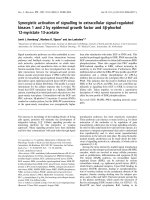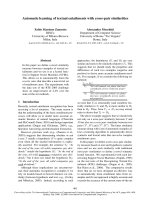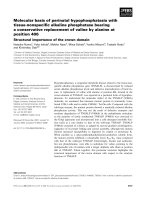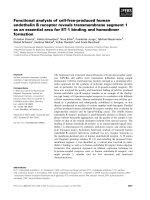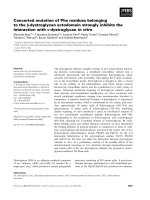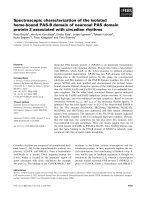Báo cáo khoa học: "Clinical significance of 4 patients with chronic hepatitis B achieving HBsAg clearance by treated with pegylated interferon alpha-2a for less than 1 year: a short report" pot
Bạn đang xem bản rút gọn của tài liệu. Xem và tải ngay bản đầy đủ của tài liệu tại đây (195.94 KB, 3 trang )
BioMed Central
Page 1 of 3
(page number not for citation purposes)
Virology Journal
Open Access
Short report
Clinical significance of 4 patients with chronic hepatitis B achieving
HBsAg clearance by treated with pegylated interferon alpha-2a for
less than 1 year: a short report
Jin Yang
1
and Lian-san Zhao*
2
Address:
1
Department of Infectious Diseases, Nanshan Affiliated Hospital of Guangdong Medical College, Shenzhen 518052, China and
2
Center
of Infectious Diseases, National Key Laboratory of Biotherapy for Human Diseases, West China Hospital, Sichuan University, Chengdu 610041,
Sichuan Province, China
Email: Jin Yang - ; Lian-san Zhao* -
* Corresponding author
Abstract
We report 4 chinese patients with hepatitis B e antigen-positive chronic hepatitis B achieving
clearance of HBsAg by using pegylated interferon alpha-2a for less than 1 year, to provide one
clinical clue for the treatment of chronic hepatitis B.
Background
Chronic infection with Hepatitis B virus(HBV) is a major
global health problem, affecting 350–400 million people
worldwide [1,2]. Patients who have HBV infection with
positivity for hepatitis B e antigen(HBeAg) and persist-
ently active disease have increased risks for progressive
disease leading to liver cirrhosis and hepatocellular carci-
noma[3]. Therefore, for patients with HBeAg positive
chronic hepatitis B(CHB), anti-viral therapy is most
important if they have indications for treatment. The end
points to assess efficacy of therapy include: reduction of
serum HBV DNA to the undetectable level, normalization
of alanine aminotransferase(ALT) levels, HBeAg serocon-
version and an improvement of liver disease at histol-
ogy[4]. But it is gradually thought that the ultimate
therapeutic goal of anti-HBV therapy should furthermore
make patients achieve clearance of hepatitis B surface anti-
gen(HBsAg) or even HBsAg seroconversion [5,6]. In view
of current anti-HBV drugs, however, it is extremely diffi-
cult to implement this goal. Nevertheless, on condition
that there is a treatment with effective anti-viral drugs and
appropriate therapeutic schemes, some patients may still
be able to achieve it.
Methods
Patients
All 4 patients aged from 14 to 49 yrs-old, including 3
males and 1 female, had suffered from CHB for 1 to 3
years with the sera profile of HBeAg, HBsAg positive, and
HBV DNA leveled from 2.71 × 10
6
copies/mL to 5.00 ×
10
7
copies/mL. They came to our hospital for pegylated
interferon alpha-2a(Pegasys) treatment from March 2006
to Ten 2007. All of them had neither complications nor
other accompanying diseases, also with no history of anti-
HBV drug use.
Methods of treatment
Classification of methods
Pegasys monotherapy Case 1 was treated with pegasys at a
dose of 135 ug intracutaneously one time per week(for
her age was below 18). Case 2 was treated with pegasys at
a dose of 180 ug intracutaneously one time per week.
Published: 8 July 2009
Virology Journal 2009, 6:97 doi:10.1186/1743-422X-6-97
Received: 24 April 2009
Accepted: 8 July 2009
This article is available from: />© 2009 Yang and Zhao; licensee BioMed Central Ltd.
This is an Open Access article distributed under the terms of the Creative Commons Attribution License ( />),
which permits unrestricted use, distribution, and reproduction in any medium, provided the original work is properly cited.
Virology Journal 2009, 6:97 />Page 2 of 3
(page number not for citation purposes)
Sequential therapy As both leucopenia and thrombocyto-
penia occurred in case 3 and case 4 during the treatment
of pegasys, we adopted sequential therapy with pegasys
and entecavir(Baraclude). Pegasys was administered at a
dose of 180 ug intracutaneously one time per week. Bara-
clude was administered at a dose of 0.5 mg orally one time
per day.
Periodic monitoring of anti-viral therapy
Leukocyte and platelet counts, serum HBV DNA and ALT
were detected once every month. HBV markers(HBsAg
and anti-HBs, HBeAg and anti-HBe, anti-HBc) were
detected once every three months. Among them, serum
HBV DNA was arrayed by fluorescent quantitative PCR
and HBV markers were arrayed by ELISA.
Results
Therapeutic efficacy
Within less than 1 year, serum HBV DNA loss, ALT nor-
malization, HBeAg seroconversion, HBsAg clearance
occurred in the 4 patients treated with either pegasys
monotherapy (the longest period of treatment was 40
weeks, the shortest period of treatment was 20 weeks) or
sequential therapy with pegasys and baraclude (the long-
est period of treatment with pegasys was 24 weeks, the
shortest period of treatment with pegasys was 16 weeks).
Among them, the latest time when HBsAg clearance
occurred (in case 4) was at week 44, and the earliest time
when HBsAg clearance occurred (in case 1) was at week
17. Furthermore, HBsAg seroconversation occurred in
case 1 at week 20, which is sustained positive in 48 weeks
follow-up, while HBsAg negative also kept steady in case
2, case 3, case 4 in 60 weeks follow-up, 60 weeks follow-
up, 72 weeks follow-up, respectively. All of them are kept
under observation until now. The Variations of sera HBV
DNA, ALT and HBV markers in the four patients are out-
lined in Table 1.
Adverse events
During the course of pegasys treatment, apparent reduc-
tion of leukocyte and platelet counts had occurred in 2
patients (case 3 and case 4) at week 4 and week 10 of ther-
apy respectively, but returned to baseline levels one
month after sequential therapy was adopted (pegasys was
paused temporarily, baraclude was administered until the
leukocyte and platelet counts recovered). There were no
other remarkable adverse events in all the four cases dur-
ing the total course of anti-viral therapy.
Discussion
The aims of treatment for CHB are to achieve sustained
suppression of HBV replication, thereby inducing remis-
sion of liver diseases and interrupting progression to liver
cirrhosis or hepatocellular carcinoma[7]. Pegylated inter-
feron alpha-2a is created by attaching a large, branched,
40-kD polyethylene glycol molecule to interferon alfa-
2a[8], This allows for convenient once-weekly dosing,
with effective serum levels maintained throughout the
dosing interval[9]. It could efficaciously inhibit the repli-
cation of HBV and help eradicate HBV infectious hepato-
cytes by dual anti-viral and immunomodulatory mode of
action[10]. In contrast to nucleoside analogues, pegylated
interferon alpha-2a has a higher rate of HBeAg serocon-
version, lower rate of relapse after treatment cessation,
moreover, it has not been observed to induce mutation of
HBV [11,12]. However, it has a few adverse events such as
transient flu-like symptoms, depression and abnormal
blood counts [13,14]. In this study, both leucopenia and
thrombocytopenia had been observed in case 3 and case
4, so we adopted sequential therapy with pegasys and bar-
aclude (one kind of nucleoside analogues). The results
showed that their leukocyte and platelet counts gradually
returned to the baseline levels one month after pegasys
was paused and baraclude was administered sequentially,
then we continued the administration of pegasys. For the
reason that sequential therapy could effectively evade the
Table 1: Therapeutic efficacy of pegasys in 4 patients with chronic hepatitis B
Characteristics Case 1 Case 2 Case 3 Case 4
Sex Female Male Male Male
Age(yr) 14 24 39 49
Course of disease
a
(yr)321 1
Therapy Monotherapy Monotherapy Sequential therapy Sequential therapy
Course of treatment
b
(wk) 36 40 24 44
HBV DNA undetectable
c
Week 14 Week 16 Week 20 Week 14
ALT normalization Week 36 Week 26 Week 23 Week 14
HBeAg seroconversion Week 16 Week 22 Week 23 Week 38
HBsAg clearance Week 17 Week 40 Week 24 Week 44
HBsAg seroconversion Week 20
yr, year; wk, week; ALT, alanine aminotransferase; HBeAg, hepatitis B e antigen; HBsAg, hepatitis B surface antigen; HBV, hepatitis B virus.
a
interval between the first time when HBsAg-positive was detected and the date before treatment.
b
cumulate course between the first day of anti-HBV treatment and the date when complete response occurred.
c
HBV DNA<1000 copies/ml.
Publish with BioMed Central and every
scientist can read your work free of charge
"BioMed Central will be the most significant development for
disseminating the results of biomedical research in our lifetime."
Sir Paul Nurse, Cancer Research UK
Your research papers will be:
available free of charge to the entire biomedical community
peer reviewed and published immediately upon acceptance
cited in PubMed and archived on PubMed Central
yours — you keep the copyright
Submit your manuscript here:
/>BioMedcentral
Virology Journal 2009, 6:97 />Page 3 of 3
(page number not for citation purposes)
inherent adverse events of pegasys and meanwhile, nucle-
oside analogues could keep sustained suppression of HBV
during the time when pegasys is paused, so the advanta-
geous efficacy of pegasys could be brought into play as
much as possible.
By analyzing above materials, we had observed one phe-
nomenon that the clearance of HBsAg occurred in the 4
patients not very long(1 wk, 18 wks, 1 wk and 6 wks,
respectively) after they had achieved HBeAg seroconver-
sion. This may imply that pegylated interferon alpha-2a
probably plays an important role in helping clear HBsAg
by means of activating the host immune reaction. Addi-
tionally, ALT levels in the 4 patients were elevated during
treatment but gradually normalized at the end of therapy,
they also had no clinical symptoms. Considering that
pegylated interferon alpha-2a takes effect by improving
the host immune function, we suppose the occurrence of
transient elevated ALT might be a reflection of the course
during which HBV infectious hepatocytes are being eradi-
cated.
Although limited case numbers are reported in this article
and more patients need to be included for further study,
one certain clue, which can be provided to clinical doc-
tors, is that some patients with HBeAg-positive CHB could
probably be expected to achieve the ideal therapeutic goal
of HBeAg seroconversion, HBsAg clearance and even
HBsAg seroconversion if they are treated with effective
anti-viral drugs and appropriate therapeutic schemes.
Conclusion
Based on our clinical observation, either pegasys mono-
therapy or sequential therapy with pegasys and baraclude
is efficacious and relatively safe for treating patients with
CHB.
Competing interests
The authors declare that they have no competing interests.
Authors' contributions
YJ conceived the study and made substantial contribu-
tions to its design, acquisition, analysis and interpretation
of data. ZL participated in the design and revised the man-
uscript critically for important intellectual content.
Acknowledgements
We are grateful to Ping Feng for her helpful comments and suggestions.
References
1. Lai CL, Ratziu V, Yuen MF, Poynard T: Viral hepatitis B. Lancet
2003, 362:2089-94.
2. Mohanty SR, Kupfer SS, Khianiv : Treatment of chronic hepatitis
B. Nat clin pract Gastroenterol Hepato 2006, 3:446-458.
3. Yang HI, Lu SN, Liaw YF, You SL, Sun CA, Wang LY, Hsiao CK, Chen
PJ, Chen DS, Chen CJ: Taiwan Community-Based Cancer
Screening Project Group. Hepatitis B e antigen and the risk
of hepatocellular carcinoma. N Engl J Med 2002, 347:168-74.
4. Sherman M: Personal view: the management of chronic hepa-
titis B infection. Aliment Pharmacol Ther 2006, 23:857-869.
5. Papatheodoridis GV, Manesis E, Hadziyannis SJ: The long-term out-
come of interferon-alpha treated and untreated patients
with HBeAg-negative chronic hepatitis B. J Hepatol 2001,
34:306-13.
6. EASL International Consensus Conference on Hepatitis B: 13–14
September, 2002 Geneva, Switzerland: consensus state-
ment(long version). J Hepatol 2003, 39(Suppl 1):S3-S25.
7. Lok AS, McMahon BJ: Chronic hepatitis B. Hepatology 2007,
45:507-39.
8. Bailon P, Palleroni A, Schaffer CA, Spence CL, Fung WJ, Porter JE,
Ehrlich GK, Pan W, Xu ZX, Modi MW, Farid A, Berthold W, Graves
M: Rational design of a potent, long-lasting form of inter-
feron: a 40 kDa branched polyethylene glycol-conjugated
interferon alpha-2a for the treatment of hepatitis C. Bioconjug
Chem 2001, 12:195-202.
9. Perry CM, Jarvis B: Peginterferon-alpha-2a (40 kD): a review of
its use in the management of chronic hepatitis C. Drugs 2001,
61:2263-88.
10. Craxi A, Cooksley WG: Pegylated interferons for chronic hep-
atitis B. Antiviral Res 2003, 60:87-89.
11. Cooksley WG, Piratvisuth T, Lee SD, Mahachai V, Chao YC, Tanwan-
dee T, Chutaputti A, Chang WY, Zahm FE, Pluck N: Peginterferon
alpha-2a(40 KD): an advance in the treatment of hepatitis B
e antigen-positive chronic hepatitis B.
J Viral Hepatitis 2003,
10:298-305.
12. Tillmann HL: Antiviral therapy and resistance with hepatitis B
virus infection. World J Gastroenterol 2007, 13:125-140.
13. Marcellin P, Lau GK, Bonino F, Farci P, Hadziyannis S, Jin R, Lu ZM,
Piratvisuth T, Germanidis G, Yurdaydin C, Diago M, Gurel S, Lai MY,
Button P, Pluck N: Peginterferon Alfa-2a HBeAg-Negative
Chronic Hepatitis B Study Group. Peginterferon alfa-2a
alone, lamivudine alone, and the two in combination in
patients with HBeAg-negative chronic hepatitis B. N Engl J
Med 2004, 351:1206-17.
14. Lau GK, Piratvisuth T, Luo KX, Marcellin P, Thongsawat S, Cooksley
G, Gane E, Fried MW, Chow WC, Paik SW, Chang WY, Berg T, Fli-
siak R, McCloud P, Pluck N: Peginterferon Alfa-2a HBeAg-Posi-
tive Chronic Hepatitis B Study Group. Peginterferon Alfa-
2a, lamivudine, and the combination for HBeAg-positive
chronic hepatitis B. N Engl J Med 2005, 352:2682-95.
![Tài liệu Báo cáo khoa học: The stereochemistry of benzo[a]pyrene-2¢-deoxyguanosine adducts affects DNA methylation by SssI and HhaI DNA methyltransferases pptx](https://media.store123doc.com/images/document/14/br/gc/medium_Y97X8XlBli.jpg)
